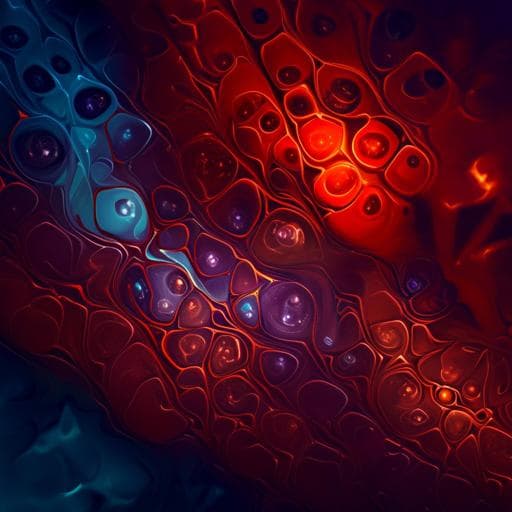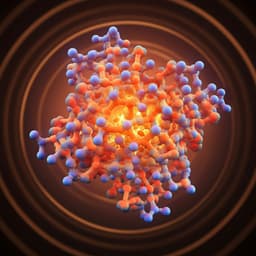
Food Science and Technology
Comparing the thermal stability of 10-carboxy-, 10-methyl-, and 10-catechyl-pyranocyanidin-3-glucosides and their precursor, cyanidin-3-glucoside
D. M. Voss, G. Miyagusuku-cruzado, et al.
Explore the remarkable findings of Danielle M. Voss, Gonzalo Miyagusuku-Cruzado, and M. Mónica Giusti, who uncovered that pyranoanthocyanins (PACNs) possess significantly greater thermal stability than their anthocyanin precursor, cyanidin-3-glucoside. Their work highlights the remarkable longevity of these compounds and reveals intriguing insights into their degradation products.
~3 min • Beginner • English
Introduction
Pyranoanthocyanins (PACNs) are anthocyanin (ACN)-derived pigments with an additional pyran ring between the C4 and C5-OH positions that contribute to wine and food color stability. They form via cycloaddition between an ACN (with a free 5-OH) and a reactive cofactor (e.g., acetone, pyruvic acid, caffeic acid) possessing an enolizable/vinyl carbon. Prior work shows PACNs display improved color stability across pH, better resistance to ascorbic acid bleaching, and improved thermal stability relative to parent ACNs, with most studies focusing on malvidin-derived PACNs. Cyanidin-3-glucoside (Cy3G) is abundant in nature, making it a practical precursor for PACN formation. ACNs typically degrade thermally via C2 hydration to a colorless chalcone followed by ring cleavage into phloroglucinaldehyde (A-ring) and protocatechuic acid (B-ring). Evidence for analogous hydration/chalcone pathways in PACNs is limited, and hydrated PACN intermediates are often not detected after pH jumps. Hypothesis: Cy3G-derived PACNs would exhibit improved thermal stability relative to Cy3G and potentially form different degradation products; the nature of the C10 substitution (carboxy, methyl, catechyl) would modulate stability and degradation behavior. Objective: Compare thermal stability using spectrophotometric and chromatographic methods and identify degradation products for three Cy3G-derived PACNs versus Cy3G to elucidate how C10 substitution influences PACN stability and degradation pathways.
Literature Review
- PACNs were first identified in aged red wine and contribute to color stability and tawny hues during aging. They also occur in aged juices, sumac, and strawberries, and exhibit antioxidant/anti-inflammatory properties.
- PACN formation depends on pH, temperature, cofactor type and concentration, and yeast presence/strain. Under accelerated conditions, caffeic acid is an efficient cofactor yielding 10-catechyl PACNs.
- Compared with parent ACNs, PACNs retain color over broader pH and resist ascorbic acid bleaching. Methyl-pyranoanthocyanidins retain significant absorbance after heating where anthocyanidins degrade; malvidin-PACNs show 3.5–7× longer half-lives than the parent ACN at high temperature/low pH.
- ACN thermal degradation proceeds via C2 hydration to chalcones and cleavage to phloroglucinaldehyde (PGA) and protocatechuic acid (PCA). For PACNs, evidence of hydration is sparse; most pH-jump studies do not detect hydrated forms, suggesting potential differences in pathways.
- Prior comparative stability among malvidin-derived PACNs often ranked 10-methyl > 10-catechyl > 10-carboxy (at pH 1, 98 °C), but pH and time can alter relative stability. Electron effects of C10 substituents (catechol delocalization, methyl donating, carboxyl withdrawing) are expected to modulate C2 electrophilicity and hydration propensity.
Methodology
Materials: Commercial elderberry (Sambucus nigra) anthocyanin powder (Cy3G-rich) was used to generate PACNs with acetone, pyruvic acid, or caffeic acid as cofactors. Standards for protocatechuic acid (PCA) and phloroglucinaldehyde (PGA) were obtained for confirmation. All reagents were analytical grade.
PACN formation: Elderberry ACNs were extracted in acidified water. Formation conditions:
- 10-carboxy-PACN (pyruvic acid): ACN:cofactor 1:200 molar ratio, pH 3.1, room temperature, 15 days.
- 10-methyl-PACN (acetone): ACN:cofactor 1:50, pH ~3.1, room temperature, ~45 days.
- 10-catechyl-PACN (caffeic acid): ACN:cofactor 1:30, pH 3.1, 45 °C, up to 4 days.
Semi-purification and isolation: Formed mixtures were C18 SPE purified; solvents removed by rotary evaporation/vacuum evaporation. Target pigments were isolated by semi-preparative HPLC (Shimadzu Prominence; formic acid/water and acetonitrile mobile phases; 12 mL/min; Synergi Max-RP or Luna PFP columns). Post-isolation, samples underwent SPE reconcentration. Cy3G, 10-catechyl-PCy3G, and 10-methyl-PCy3G were stored as aqueous concentrates; 10-carboxy-PCy3G was stored dissolved in acidified methanol due to precipitation.
Heat treatments: Isolates were thawed (sonication), mixed with acidified MeOH, diluted into pH 3.0 water (HCl-acidified) to 1.5% MeOH final. pH adjusted to 3.00 ± 0.05. Each sample was normalized to absorbance 0.82 ± 0.05 at its λmax. Aliquots in amber microtubes were N2-flushed. Heating in water bath at 90.0 ± 2.5 °C; samples removed every 2 h up to 12 h and at 15 h total. Chilled on ice then equilibrated to room temperature before measurement. Room-temperature controls were held 6 and 12 h.
Spectrophotometry and color: Absorbance spectra (260–700 nm; 5-nm steps; targeted 465–515 nm at 1-nm steps) were collected (SpectraMax M2). CIE L*a*b* color (D65, 10°) was computed from 380–700 nm data; ΔELab calculated. Total pigment content used the pH differential method (measured at pH 1.0 for PACNs) expressed as mg Cy3G equivalents/L using Cy3G molar absorptivity 26,900 and MW 449.2 g/mol.
UHPLC-PDA-ESI-MS/MS and QTOF-MS: Identification, purity, and monitoring used Shimadzu Nexera-i LC2040C 3D with PDA coupled to LCMS-8040 (ESI). Analytical column: Restek Ultra IBD 1.9 µm, 50 × 2.1 mm with guard; 50 °C; mobile phases 4.5% formic acid in water (A) and acetonitrile (B); flow 0.25 mL/min; defined gradients for purity and monitoring. Detection used 260–700 nm max plot chromatograms for peak areas. MS settings included positive/negative ion scans (m/z 100–1200), precursor ion scans, SIM for pigments and expected degradation products, product ion scans (10–50 eV), and neutral loss scans for glucose (162 m/z). Accurate m/z for PACNs were confirmed by Agilent 6550 QTOF-MS (UHPLC-DAD; CSH C18 150 × 2.1 mm; 0.3 mL/min; 5% formic acid in water/acetonitrile).
Kinetics and statistics: Degradation was modeled as first-order for absorbance at λvis-max and pigment content. For PACNs, models were constrained to the plateau values obtained from Cy3G degradation for better endpoint prediction. One-way ANOVA with Bonferroni post hoc tests assessed differences across pigments and times; nested analyses when possible. Triplicate experiments; p < 0.05 considered significant.
Key Findings
- Identification and purity: Three PACNs (10-carboxy-, 10-methyl-, 10-catechyl-PCy3G) were formed from Cy3G with distinct retention times and hypsochromically shifted λmax versus Cy3G. Accurate m/z (QTOF) confirmed: 10-carboxy-PCy3G 517.0988, 10-methyl-PCy3G 487.1244, 10-catechyl-PCy3G 581.1283. All isolates >96% purity.
- Room temperature behavior: 10-carboxy-PCy3G precipitated during prep and showed losses in apparent absorbance/pigment content and notable color change (ΔELab ~11.5 at 12 h), without new HPLC peaks, consistent with reversible precipitation/aggregation. 10-catechyl-PCy3G developed brown coloration on standing (ΔELab 7.0 at 6 h; 12.5 at 12 h) with spectral changes but no new chromatographic peaks, suggesting reversible aggregation. 10-methyl-PCy3G was stable (ΔELab ~1.5 at 12 h).
- Spectral thermal stability (90 °C, pH 3.0): After 2 h, absorbance at λvis-max decreased by ~47% (Cy3G), 24.4% (10-carboxy-PCy3G), 14.4% (10-methyl-PCy3G), 12.1% (10-catechyl-PCy3G). After 15 h, reductions were ~83.5% (10-carboxy), 51.2% (10-methyl), 40.4% (10-catechyl); Cy3G nearly completely degraded. First-order kinetics fit well (R2 ≥ 0.96). Half-lives for absorbance: Cy3G 1.99 h; 10-carboxy 4.26 h; 10-methyl 12.40 h; 10-catechyl 17.16 h.
- Pigment content: After 2 h, losses were <10% for 10-catechyl and 10-methyl, ~24% for 10-carboxy, ~47% for Cy3G. After 15 h, Cy3G pigment content ~0; PACNs retained pigment with 10-catechyl most stable (p < 0.01). First-order kinetics (R2 ≥ 0.97) with half-lives: Cy3G 2.22 h; 10-carboxy 5.41 h; 10-methyl 13.93 h; 10-catechyl 20.96 h.
- Color: All samples became lighter (L*↑), less saturated (Cab*↓), and shifted to higher hue with heating. A discernible color change (ΔELab ≥ 5) occurred by 2 h for Cy3G, 10-carboxy, and 10-methyl; for 10-catechyl it took 6 h.
- UHPLC-PDA peak area (degradation): After 6 h, 10-methyl and 10-catechyl were more resistant to loss than 10-carboxy and Cy3G (p < 0.01). After 12 h, 10-methyl-PCy3G had the smallest parent-peak loss (most stable by UHPLC-PDA; p < 0.01 vs 10-catechyl). Considering total pigmented area, 10-catechyl retained more due to a colored degradation compound (λmax 478 nm).
- Degradation products: Cy3G formed PCA (λmax 259 nm; m/z 155) and PGA (λmax 291 nm; m/z 155), plus a tentative PCA/PGA dimer or adduct (λmax 293 nm; m/z 291). All PACNs produced PCA, indicating a similar hydration/chalcone-mediated pathway. Unique PACN derivatives were observed: 10-carboxy derivative (λmax 267 nm; m/z not detected), 10-methyl derivative (λmax 266 nm with secondary 349 nm; m/z 221; fragments 203, 147, 105, 77, 69), and a colored 10-catechyl derivative (λmax 478 nm; m/z 315; fragments 297, 241, 213, 139, 137, 69). The 10-catechyl derivative likely contributed to enhanced color stability.
- Overall: PACNs displayed 2.1–9.4× longer half-lives than Cy3G depending on metric. 10-methyl-PCy3G was most stable by chromatographic parent-peak retention; 10-catechyl-PCy3G exhibited the most stable color due to a colored degradation product. PCA formation across all samples supports a common hydration-initiated degradation mechanism.
Discussion
Findings confirm that Cy3G-derived PACNs are markedly more thermally stable than Cy3G at pH 3.0, 90 °C, addressing the hypothesis of enhanced stability. The nature of the C10 substitution modulates stability and degradation outcomes:
- 10-methyl-PCy3G showed the greatest resistance to parent-peak loss (UHPLC-PDA), consistent with an electron-donating methyl group and reduced C2 electrophilicity, slowing hydration.
- 10-catechyl-PCy3G showed superior color retention due to formation of a colored degradation product (λmax 478 nm), which maintained visible absorbance despite parent depletion. The catechol moiety likely enhances positive charge delocalization, further reducing C2 electrophilicity, and may facilitate conjugation in degradation products.
- 10-carboxy-PCy3G was least stable among PACNs, consistent with electron-withdrawing carboxyl effects increasing C2 electrophilicity and hydration rate.
The detection of PCA in all PACN samples indicates that, despite reduced propensity for hydration in PACNs, elevated thermal energy can overcome the activation barrier, leading to a degradation pathway analogous to ACNs (hydration to chalcone followed by ring cleavage). The discrepancy between spectrophotometric and chromatographic stability for 10-catechyl-PCy3G underscores the role of colored degradation products in perceived stability. Practically, PACN structure—dictated by cofactor—should be selected to match application needs (e.g., colorfastness vs parent retention). Room temperature handling showed reversible aggregation/precipitation for carboxy and catechyl PACNs, suggesting formulation adjustments (acidified MeOH, solvent, or stabilizers) may be needed for applications.
Conclusion
PACNs derived from Cy3G (10-carboxy-, 10-methyl-, 10-catechyl-PCy3G) exhibit substantially greater thermal stability than Cy3G at pH 3.0 and 90 °C. Stability depends on the C10 substituent: 10-methyl-PCy3G was most stable by UHPLC-PDA, while 10-catechyl-PCy3G showed the highest color stability due to a colored degradation product. All PACNs produced protocatechuic acid upon heating, indicating a degradation pathway similar to ACNs via hydration and chalcone intermediates. These insights highlight structure–stability relationships critical for optimizing PACNs as natural colorants.
Future work: fully characterize the unidentified PACN degradation compounds (especially the 10-carboxy derivative), directly probe hydrated PACN intermediates, evaluate stability across broader pH/temperature/matrix conditions, address aggregation/precipitation behavior in formulations, and expand to other ACN aglycones/cofactors to generalize structure–stability rules.
Limitations
- Hydrated PACN intermediates and chalcones were not directly detected by UHPLC-MS/MS; their involvement is inferred from spectral changes and degradation products.
- One pH (3.0) and a single high temperature (90 °C) were tested; generalizability to other conditions and food matrices may be limited.
- Kinetic models for PACNs were constrained to Cy3G’s plateau values, introducing assumptions about end states.
- Some degradation products were only tentatively identified (e.g., 10-carboxy-PACN derivative m/z not detected; PCA/PGA adduct assignment tentative).
- Room-temperature storage showed reversible aggregation/precipitation for some PACNs, complicating interpretation without direct precipitation measurements (amber tubes hindered visualization).
- Only Cy3G-derived PACNs and three cofactor types were evaluated; results may differ with other aglycones/substituents.
Related Publications
Explore these studies to deepen your understanding of the subject.







